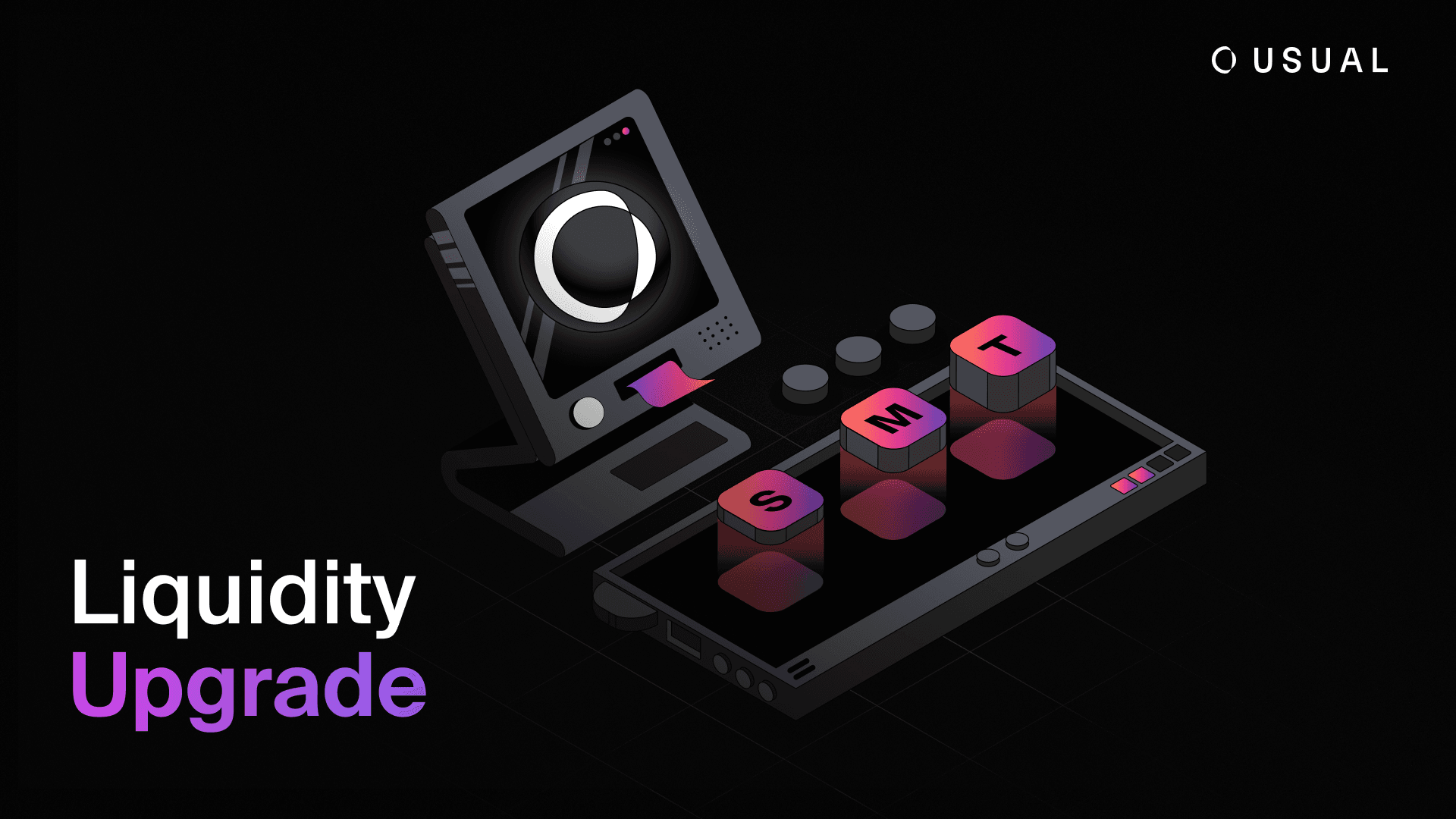New USD0++ roadmap for stability and predictability.
TLDR
Context
Recent USD0++ volatility has raised legitimate concerns about the protocol.
The USD0++ TVL decreased by $250M through the Early Redemption mechanism, capturing 50 million USUAL tokens. Representing 1/4 of the supply available on exchanges, this significantly reduced the circulating supply, effectively stabilizing the USD0++ yield above 20% APY.
In addition, $1.15M USD0 in weekly revenue was distributed to USUAL stakers, representing 43% of the USUAL supply. This makes Usual the first DeFi protocol to redistribute 100% of the value generated directly to its users. The APY exceeded 100%, paid entirely in USD0.
Goal
Contributors have been working over the past 10 days to increase & stabilize the USD0++ price, enhance its arbitrage capacity, and improve its overall utility.
Key Initiatives & Proposals
1. Liquidity Proposal
Stability Loans (USL): Borrow USD0 at low rates using USD0++ as a collateral during depegs, boosting liquidity and DAO revenues. Check the proposal, here.
Stability Buffer (USB): Institutional management of the USD0 buffer for arbitrage and liquidity stabilization.
Floor Price Adjustments: Proposal to increase to $0.92 to enhance liquidity and achieve a more balanced equilibrium with the USUAL burning mechanism.
2. New Features
USD0++ Vaults: Invest USD0++ in productive assets while retaining USUAL yield.
3. Market Protection
Protecting USUAL’s Value: The DAO aims to protect USD0++ by maintaining USUAL’s fair value on secondary markets, ensuring yield sustainability, and reserving the discretionary option to deploy resources.
4. Roadmap Highlights
New vaults, ETH0/BTC0, USD0 & USUAL Morpho vault, Simple ve system for USUALx.
Governance enhancements: Moving towards decentralized, veto-based governance to involve all USUALx holders and safeguard protocol continuity.
Situation
Usual believes USD0++ is one of the cornerstone assets of the protocol, providing a robust collateral for DeFi or CEXs as well as an asset that offers an attractive and sustainable yield while diversifying and decentralizing the protocol’s ownership. Considering this, one of Usual’s core missions is to provide mechanisms that optimize USD0++ parity with USD0.
In line with this long-term vision, USD0++ has always had a four-year staking period, with market unstaking only briefly available during the listing phase. Prior to November, unstaking was not possible, even as parity with USD0 was maintained. This approach allowed for a transitional period before the deployment of its conditional version and the introduction of the floor mechanism, which represents an unstaking fee paid in USD0++. However, this transition caused significant imbalances and panic, ultimately leading to the current stagnation of the Usual protocol.
This situation is expected to be temporary, as the introduction of numerous new features and modules will soon provide the protocol with renewed momentum. These are functionalities partially or entirely designed to create stability for USD0++. These improvements primarily aim to increase the utility of USD0++, thereby enhancing its value. They also facilitate greater liquidity injections against USD0++, providing more stability and flexibility for users. Finally, we have gathered extensive feedback over recent days and are making every effort to incorporate it when it is relevant to the protocol’s stability and balance.
Thus, it appears that the two main issues faced by users are:
Liquidity of USD0++: Liquidity is critical for users to easily manage their leveraged positions and to switch between USD0++ and other protocols. It also contributes to achieving more straightforward parity.
Predictability of events: While a protocol must evolve,, this demand for predictability has been acknowledged. All measures and proposals will be subject to a veto process, ensuring as much predictability as possible.
All that being said, Usual aims to implement a series of measures to usher in a new era for Usual and USD0++. Please discover them below.
Usual Stability Loans (USL)
The Usual Stability Loans module is a DAO feature that will allow users to take decentralized loans at a low fixed rate when USD0++ is depegged. Users will be able to borrow USD0 against their USD0++ (and similar assets) when USD0++ trades below parity. Similar to DAI’s D3M or Frax’s AMOs, this feature also enables the creation of strategies for advanced users while contributing to the protocol’s stabilization.
This functionality offers numerous advantages:
Injection of billions in potential liquidity into USD0++
Highly attractive yields and dual gains through arbitrage and rewards
Pressure towards parity when USD0++ deviates
Increased DAO revenues and higher income per USUAL due to interest rates
No theoretical risk of collateralizing USD0 or circulating USD0++
No theoretical risk of revenue loss for the DAO over the four-year period
No theoretical solvency risk for the DAO
Perfect predictability for users, who can lock in a rate permanently and even know their potential liquidation date in advance
This feature addresses the concerns outlined earlier and opens up vast possibilities for Usual and USD0++.
The implementation of this measure in the next coming days will be subject to a veto right by holders and will be deployed on the Euler protocol due to its features that align perfectly with the flexibility required for this product.
A draft for the mechanism is already available for the product, you can view it here. Please note that this sample is not final and the mechanism is subject to change before the official proposal is submitted.
Usual Stability Buffer (USB)
The Usual Stability Buffer (USB) is a DAO module for an arbitrage wallet run by top-tier market makers or institutions. Its goal is to stabilize the protocol through active market making. Backed by hundreds of millions, the wallet is fully transparent, with some keys held by the DAO. Funds deploy in USD0++ during liquidity events or rest in a Morpho vault as USD0 when idle, ensuring proper collateralization. Market makers profit only after lenders’ interests are covered.
This module offers several advantages:
Efficient management of USD0++ and USD0 liquidity through constant market making.
A buffer of approximately $200M, managed by institutional partners, capable of absorbing shock situations similar to those previously experienced.
Increased liquidity for borrowers when USD0++ is at parity.
Higher DAO revenues through arbitrage profits and the USUAL earned via USD0++, which will be burned beyond the repayment amount.
The initial proposed version will be a simplified one with the elements mentioned in the description.
Future enhancements could include:
Expanding the scope of actions to create more added value for USUAL utility.
Allowing repurchased USD0++ to be prioritized for minting requests when the buffer is already full.
Introducing additional tools and features to refine market-making strategies and maximize efficiency.
Leveraging arbitrage profits and expanded operations to further increase DAO revenues and support token burns.
As with the Usual Stability Loans, all details will be outlined more precisely in a proposal subject to the holders’ veto. Contributors welcome any proposal from reputable lenders and market actors. Usual is already in talks with various actors.
Increased Floor Price to 0.92
Context and Rationale
The USD0++ floor price, introduced just over a week ago alongside the early unstaking mechanism, has contributed to current liquidity constraints for USD0++ and broader concerns within the community. Communication surrounding these mechanisms may not have been as clear as needed. It is important to clarify that the floor price does not alter the intrinsic value of USD0++, which represents a staked USD0. USD0++ is not a zero-coupon bond, as some have suggested. Instead, it accrues rewards in the form of USUAL, currently exceeding the risk-free rate.
Purpose of the Floor Price
The floor price was designed as an alternative to early unstaking via USUAL burning, aiming to:
Protect Users: Reduce high volatility (some LSTs are discounted by over 30%) and provide a last-resort liquidity option for users unwilling to wait six months for unstaking.
Protect the DAO & USUAL Holders: Secure four years of DAO revenue, preserve USUAL value, and ensure USD0++ yields, derived from the protocol’s ownership and underlying assets.
Implementation & Feedback
The floor price was determined using a discounted cash flow model based on the current yield curve, ensuring alignment with the DAO’s projected revenues. While grounded in rigorous and transparent logic, we acknowledge that this mechanism, effectively acting as a secondary unstaking fee, may not fully align with the crypto ecosystem’s faster pace and higher yield expectations compared to traditional finance.
That said, it remains essential to protect USD0++ by reducing volatility and securing its yield. A USUAL token not anchored to strong economic fundamentals would risk devaluing USD0++. Consequently, this mechanism is critical, even if there is room for improvement.
Goal: Rationalizing USD0++ Pricing
The current USD0++ price lacks rationality. To address this, a proposal will be made in the coming days to lower the unstaking fee in USD0++ and increase the floor price. Based on recent observations, an initial floor price of $0.92 USD0 per USD0++ (a fee of $0.08) appears reasonable. Clear rules governing fee adjustments will be embedded in the smart contract, ensuring predictability.
Additionally, the interaction between the floor price and early unstaking via USUAL burning will be carefully calibrated to maintain balance between the two mechanisms and enhance alignment.
Objective
The goal is to deepen USD0++ liquidity, reposition the USD0++ price within a more rational range, enable the DAO to capture more revenue, and establish an equilibrium with the unstaking process that requires burning USUAL. Thus far, unstaking has relied solely on USUAL burning, but these adjustments aim to enhance the DAO’s efficiency while offering users clear and predictable time-based fee structures.
Renaming for Clarity
To improve clarity, early unstaking will be rebranded to clearly present its two options: a fee paid in USD0++ or in USUAL.
Timeline
To protect USUAL's value and maintain stability, analyses are underway. If the results are conclusive, a proposal will be presented for voting in the coming days. It will be thoroughly detailed and submitted to the DAO for veto before implementation. We remain committed to monitoring user behavior, incorporating feedback, and ensuring the protocol’s stability and alignment with user needs.
iUSD0++ vaults & proto-ETH0
As announced last week, the iUSD0++ vaults are in their final stages of development and testing before release. USD0++ placed in these vaults is “invested” in other strategies. These tokens are redeemed on the primary market and reinvested in other productive assets at a value of 1USD allowing the user to have exposure equal to their principal. This adds substantial additional utility to USD0++, allowing exposure to numerous strategies in DeFi while continuing to benefit from USUAL yield and part of the yield generated by the underlying asset. Symmetrically, with deposits considered at 1 USD, withdrawals are also executed at a 1:1 ratio in USD0++, preventing any arbitrage loopholes.
The first iUSD0++ vault to launch will be an Ethena sUSDe vault, where USD0++ will be unlocked 1:1 in USD0 that will be reinvested in sUSDe. This setup allows USD0++ users to benefit from their USUAL yield and a portion of the returns generated by sUSDe and potential attached sats. Usual is actively working to roll out additional iUSD0++ vaults with exposure to Resolv, Maker and Sky, Fasanara, Superstate, and many others. Most importantly, iUSD0++ vaults will also enable implementation of the ETH0 and BTC0 value propositions. These vaults will offer exposure to ETH or BTC instead of USD0++ while still earning USUAL rewards and additional returns from LRTs, LSTs, or other layered strategies.
Once again, this feature offers numerous advantages:
Increased utility of USD0++, enabling access to other strategies.
Increased USD0++ purchases and reduced sales, as users no longer need to migrate to seek better yields.
Higher DAO revenues, which could be used for continuous buybacks and burns of USUAL tokens.
Market-leading yields through the combination of returns.
Ability to integrate the ETH0 and BTC0 value propositions.
Risk isolation, as only users within the vaults are exposed to the underlying asset’s risks.
When USD0++ is depegged, vault exposure remains valued at $1 per USD0++.
This feature meets holders’ expectations by offering additional liquidity options for USD0++ and better predictability for users, who can move between vaults at any time with a value of $1 per USD0++.
As always, these proposals will be subject to a veto by holders and will be detailed in terms of specifications before implementation.
Liquidity improvements
Since the implementation of conditional early unstaking in USUAL, the volatility of USD0++ has increased. Additionally, vaults will require new USD0 pathways to invest in underlying assets without placing excessive pressure on the USDC pool. The aim is to achieve highly efficient liquidity that serves both lending markets and DEXs, such as Fluid or Balancer. Furthermore, while instant liquidity from RWA providers is generally sufficient, continuous improvements are needed to ensure constant arbitrage in USD0/USDC pools.
This initiative should lead to the following outcomes:
Creation of new USD0++ pools with better liquidity distribution to manage volatility.
Development of new USD0 pools with stablecoins other than USDC to enable efficient vault routes and increase liquidity.
Establishment of efficient pools to support both lending markets and liquidity provisioning.
Creation of incentivized USUAL/USD0 markets.
Optimization of the reward system to leverage vote market efficiency.
These efforts aim to enhance stability through deeper liquidity and improved predictability. The more ossified the liquidity becomes, the more predictable it is for users and the protocol.
This proposal will be detailed and submitted to the DAO for veto before implementation. However, some pools may be created ahead of the proposal.
Buyback and Long
Maintaining USUAL’s fair value on secondary markets is another way to protect USD0++. Current yields and early unstaking rules encourage some market participants to short USUAL, so Usual focuses on enhancing its value. The revenue switch exemplifies this, offering over 100% APY to USUALx holders.
The DAO can partner with a professional to execute a buyback-and-long strategy that supports USUAL’s fair value and strengthens USD0++. Proposals will specify clear parameters, though timing may remain private to optimize returns. This approach can surpass simple buyback-and-burn or redistribution, with revenues ultimately flowing to USUALx and USUAL* holders.
Research continues, and any such activities will be fully transparent. This proposal will also be presented to the DAO for veto before implementation.
Governance
As highlighted in this document and in line with recent announcements, Usual is gradually transitioning to operate more like an open-source software project, with decision-making becoming increasingly decentralized.
As part of its proto-governance framework, Usual will adopt a veto-based system involving the protocol’s various stakeholders. Contributors will submit proposals that, unless they reach a specific veto threshold, will be implemented. It makes sense to include the perspectives of USUALx, USUAL*, and USD0++ holders, as these tokens represent long-term commitments within the Usual ecosystem. Initially, simple metrics will be used, with plans to introduce a more sophisticated and comprehensive governance model over time.
Proposals to improve this proto-governance system will also be subject to veto.
New integrations and roadmap
These topics are not the only focus for Usual, as many other plans are underway to stabilize the protocol and enable it to grow again. Numerous integrations are being developed to ensure Usual users have the best experience and opportunities possible.
Key integrations expected in the near future include:
USD0 Morpho vault: A vault where the DAO can initiate USD0 liquidity.
USUAL Morpho vault: Allowing USUALx holders to take leveraged positions in USUAL.
New composable products for USD0++: For example, a vault with Idle Finance enabling USD0++ tranche products.
Auto-compounding rewards: Implementation of mechanisms to auto-compound USUAL rewards.
Faster rewards distribution: Reducing the reward payout time to one day with the activation of Brevis.
Delta-neutral USUAL vault: A vault enabling the DAO to profit from short strategies, rather than limiting this advantage to a small group of users.
Simple ve system for USUALx: Establishing a vote-escrow model for governance and incentives.
These are the features we anticipate releasing soon. However, Usual’s roadmap is comprehensive, and the team plans to publish a detailed document outlining multi-year features and development while maintaining flexibility in the order of deliverables.
Mid-longer-term initiatives include:
Implementing an innovative ve-model.
Creating new synthetics like ETH0 and BTC0
Creating a dedicated L2 for USUAL use cases.
Introducing a more sophisticated revenue switch system.
Promoting USD0 as a stablecoin for utility and counterparty purposes.
This roadmap reflects Usual’s vision for sustained growth and innovation while balancing flexibility and adaptability in execution.
Methodology
This article aims to present the current reflections of Usual contributors with the objective of transparency and keeping the community updated. This paper does not guarantee the implementation of these features and modules or their parameters. The materials used for proposals submitted to veto will serve as the definitive reference for the final parameters and the detailed description of the said modules.
All mechanisms, along with their variables and operational details, will be thoroughly outlined in various proposals submitted for token holder voting.








